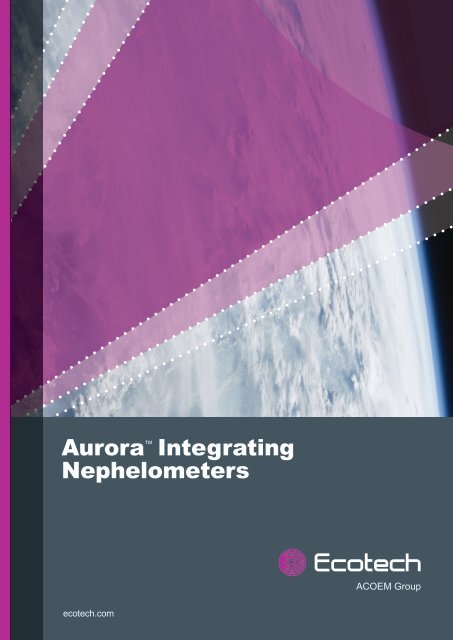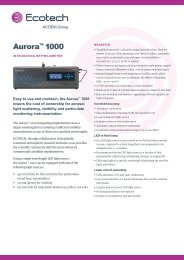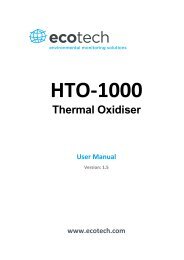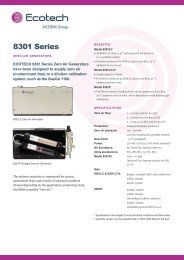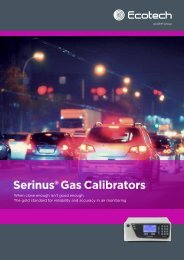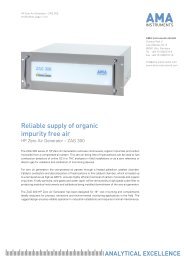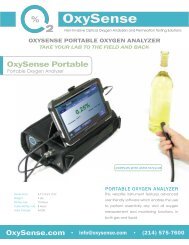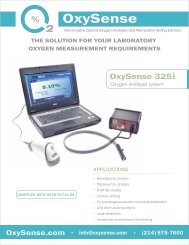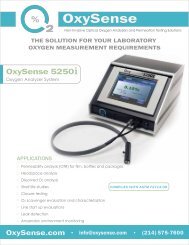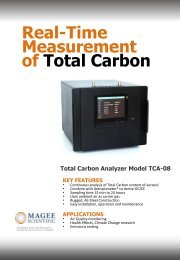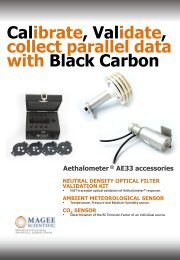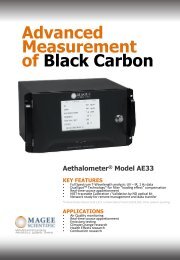ECOTECH-Aurora-Integrating-Nephelometers-Brochure-20180725
You also want an ePaper? Increase the reach of your titles
YUMPU automatically turns print PDFs into web optimized ePapers that Google loves.
<strong>Aurora</strong> <strong>Integrating</strong><br />
<strong>Nephelometers</strong><br />
Aerosol monitoring & atmospheric research<br />
ecotech.com
WORLD-CLASS AEROSOL MONITORING & MEASUREMENT<br />
Today, right around the world, atmospheric scientists and environmental agencies rely on <strong>ECOTECH</strong>’s<br />
range of <strong>Aurora</strong> integrating nephelometers. They've proven themselves to not only be accurate, flexible<br />
and easy to use, but also transportable and designed to cope with the demands of use in remote locations.<br />
• Comprehensive range of nephelometers; from single or three wavelength integrating<br />
nephelometers to a polar three wavelength integrating nephelometer<br />
• The <strong>Aurora</strong> range offers total remote control including calibration<br />
• Rugged and robust. Proven capability in remote, unattended locations for long term monitoring<br />
• Fully integrated with <strong>ECOTECH</strong>’s Airodis , the data collection, validation and reporting software<br />
• User friendly and easy to maintain in the field<br />
• Uncompromising performance with low cost of ownership.<br />
VISIBILITY APPLICATION<br />
Visibility can be impaired by anything present in the<br />
air that reduces the amount of light reaching the<br />
observer, through scattering or absorption.<br />
Common visibility deterioration is due to high particulate<br />
concentration or high humidity. Particles can be of natural<br />
or anthropogenic origin, for example, from car emissions,<br />
wood burning, sandstorms, volcanic eruptions or smog.<br />
<strong>Aurora</strong> integrating nephelometers are an ideal solution<br />
to help us in understanding, identifying and planning<br />
ways to control pollution and the imbalance in or<br />
degradation of the environment. This is why governments<br />
and Environmental Protection Authorities (EPA’s) use our<br />
<strong>Aurora</strong> in visibility applications.<br />
AUTOMOBILE APPLICATION<br />
Emissions from diesel exhaust is a known source of<br />
health deterioration. This is why reliable environmental<br />
monitoring is absolutely crucial for the automobile<br />
industry for whom compliance with regulatory standards<br />
is non-negotiable.<br />
The <strong>Aurora</strong> meets the specific requirements for<br />
measuring diesel exhaust particulate emissions, by<br />
addressing some of the monitoring concerns such as:<br />
• Linearity - The <strong>Aurora</strong> gives a linear response with<br />
emissions at extremely high particulate concentrations<br />
due to the use of optical measurement principle<br />
• Clogging - No filter used preventing clogging of the<br />
sample system<br />
Severe dust storm in Sydney, Australia<br />
• Hot sampling - Robust design of the instrument; dilution<br />
possible due to instrument being free of filter and pump.
Affordable excellence<br />
AURORA 1000<br />
Clear choice for visibility monitoring<br />
The <strong>Aurora</strong> 1000 is the perfect choice for any<br />
air quality monitoring system. It is a highly costeffective<br />
entry level instrument uncompromised<br />
in its reliability and designed to run in extreme<br />
conditions.<br />
Multiple options, features and accessories are available<br />
to be used in conjunction with the <strong>Aurora</strong> range.<br />
Refer to matrix table on page 7 for a list of options and<br />
compatibility.<br />
FEATURES<br />
Single wavelength, available in 525 nm, 450 nm or<br />
635 nm<br />
Wide measurement range (0.3 to 20,000 Mm -1 )<br />
Fully automatic calibration using internal valves; ideal for<br />
remote locations.<br />
Better correlation<br />
AURORA 2000<br />
Real-time mass concentration<br />
Using a single wavelength nephelometer (525 nm,<br />
450 nm or 635 nm) to measure aerosol light<br />
scattering in conjunction with a Spirant BAM*, the<br />
<strong>Aurora</strong> 2000 uses the reading from the Spirant<br />
BAM’s hourly average to calculate a correlation<br />
factor to derive real-time PM 2.5<br />
concentrations. When<br />
the Spirant BAM is not connected the user can<br />
manually derive and enter a correlation factor.<br />
*The Spirant BAM measures and records airborne<br />
particulate concentrations using a ß ray attenuation<br />
method.<br />
FEATURES<br />
Enables real-time PM 2.5<br />
concentration measurement in<br />
conjunction with a Spirant BAM<br />
12V DC (110-240 VAC, 50/60 Hz power converter included)<br />
13 watts nominal, 45 watts max.<br />
ecotech.com | 3
All-round capability<br />
AURORA 3000<br />
Proven results for long term monitoring<br />
The <strong>Aurora</strong> 3000 is the favoured choice of<br />
researchers as it facilitates simultaneous<br />
measurement across three wavelengths, enabling<br />
wide and in-depth analysis of the interaction<br />
between light and aerosols. Its capabilities include<br />
integrating measurements of full scatter and<br />
backscatter, making it a perfect instrument for<br />
climate change research.<br />
Like its siblings, the <strong>Aurora</strong> 3000 has a range from<br />
0.3 to 20,000 Mm -1 . A high-precision option is also<br />
available, with a lower detectable limit of 0.1 Mm -1 .<br />
FEATURES<br />
Multi-wavelength LED light source for long term stable<br />
measurements at 635 nm, 525 nm and 450 nm<br />
<strong>Integrating</strong> measurements of full scatter & backscatter<br />
Used in conjunction with the ACS 1000 for a light<br />
scattering enhancement factor measurement (optional)<br />
Automatic ball valve option: protect against contamination<br />
of a common sampling manifold, bypassing the instrument<br />
during calibration<br />
Mass flow control option enables flow to be controlled in<br />
conjunction with an external pump.<br />
AEROSOL LIGHT SCATTERING APPLICATION<br />
The <strong>Aurora</strong> integrating nephelometer measures the<br />
light scattering coefficient of ambient aerosol particles<br />
with high sensitivity and time resolution, in a wide range<br />
of monitoring and research applications, related to air<br />
pollution and climate.<br />
LONG TERM MONITORING<br />
“<br />
The direct and indirect radiative effects of aerosol particles constitute<br />
the largest uncertainty in current radiative forcing estimates of the<br />
Earth’s climatic system. In order to reduce the uncertainties associated<br />
with atmospheric aerosols in climate systems, detailed information<br />
on the temporal and spatial variability of different aerosol properties<br />
is required. Such information can be obtained from a combination of<br />
model simulations, remote sensing and continuous in-situ aerosol<br />
measurements.<br />
“<br />
Lasskso et al, 2010 ‘South African EUCAARI measurements: seasonal variation of trace gases<br />
and aerosol optical properties.’ Atmospheric Chemistry and Physics.<br />
LIGHT SCATTERING IN REMOTE LOCATIONS<br />
The <strong>Aurora</strong> range is widely used in remote and<br />
unattended locations, examples include:<br />
• Research on aerosol optical properties at high-altitude in<br />
the Mediterranean Basin conducted by the Institute of<br />
Environmental Assessment and Water Research (IDAEA-<br />
CSIC) in Montseny, Spain<br />
• Research on aerosol optical properties conducted by Paul<br />
Scherrer Institute (PSI) as part of the CATCOS project<br />
across Indonesia, Chile, Vietnam and Kenya<br />
• Research on various aerosol properties at high altitude<br />
conducted by Observatoire de Physique du Globe, France<br />
in Puit De Dôme, France.
Best in class<br />
AURORA 4000 — POLAR<br />
Measuring scattering by angular sector<br />
The <strong>Aurora</strong> 4000 builds on the same three<br />
wavelength capabilities as the <strong>Aurora</strong> 3000.<br />
This device provides measurements of light<br />
scattering within up to 18 user selectable<br />
angular sectors, using varied backscatter shutter<br />
positioning. This can contribute to determining<br />
the phase function of aerosols, which is crucial to<br />
climate research and modelling.<br />
Despite its sophisticated capabilities, the <strong>Aurora</strong> 4000<br />
maintains the same ease of use, maintenance and<br />
calibration as the rest of the <strong>Aurora</strong> range.<br />
FEATURES<br />
Wide measurement range (0.1 to 20,000 Mm -1 )<br />
18 angular sectors; full integrated scattering, as well as<br />
integrated scattering of up to 17 different angular sectors<br />
from 10˚ to 90˚ through to 170˚<br />
Raw measurement counts available for customised<br />
data analysis<br />
Automatic ball valve option: protect against contamination<br />
of a common sampling manifold, bypassing the instrument<br />
during calibration<br />
Mass flow control option enables flow to be controlled in<br />
conjunction with an external pump.<br />
AIRCRAFT MEASUREMENTS APPLICATION<br />
The <strong>Aurora</strong> is intended to meet the following<br />
critical requirements expected for aircraft<br />
measurements:<br />
• Compact and light weight<br />
• Flow control with no restrictions<br />
• Very low LDL<br />
• Small cell volume<br />
• Fast data acquisition (down to three seconds)<br />
• Low power consumption<br />
• Can be operated at -40 °C and at altitudes of<br />
up to 15,000 metres.<br />
AEROSOL LIGHT SCATTERING RESEARCH<br />
Optical closure studies:<br />
“<br />
Atmospheric aerosols play an important role in determining direct<br />
radiative transfer by scattering and absorbing solar radiation. Refractive<br />
indices are also necessary to determine the optical parameters<br />
relevant to radiative transfer such as single scatter albedo, asymmetry<br />
factor and specific absorption using Mie–Lorenz theory. Additionally,<br />
reliable phase function and polarization information is essential for the<br />
interpretation of satellite and aircraft measurements to infer aerosol<br />
optical depth, size and single scatter albedo.<br />
“<br />
H. Kim & S. E. Paulson 2013, ‘Real refractive indices and volatility of secondary organic aerosol<br />
generated from photooxidation and ozonolysis of limonene, α pinene and toluene.’ Atmospheric<br />
Chemistry and Physics.<br />
<strong>Aurora</strong> 4000 in a pressure chamber, testing the<br />
reliability when exposed to harsh conditions expected at<br />
altitudes of up to 15,000 metres.<br />
ecotech.com | 5
The perfect complement<br />
ACS 1000<br />
Innovation in hygroscopic study<br />
<strong>ECOTECH</strong>’s Aerosol Conditioning System<br />
(ACS 1000) can be used with most aerosol<br />
monitoring instruments, adjusting relative humidity<br />
with minimal particle loss to measure the effect of<br />
water uptake on the properties of aerosols. The<br />
ACS 1000 simultaneously controls differing<br />
relative humidity levels in two sample channels,<br />
allowing real-time measurement by parallel<br />
instruments for comparison.<br />
FEATURES<br />
Sample RH controllable between 40 % and 90 % with<br />
minimal particle loss<br />
Customisable flow and humidograms<br />
Autoranging power supply 110-250 VAC, 50/60 Hz<br />
Controls RH within ±0.2 % (1σ)<br />
“Ammonium sulfate particles light scattering enhancement<br />
(f(RH)) calculated (red markers) and measured by the ACS<br />
1000 (blue dots) and the WetNeph developed by the Paul<br />
Scherrer Institute (green dots). The errors bars represent<br />
the precision of the RH measurements according to the<br />
manufacturer.<br />
“<br />
Laborde et al. 2015, in prep.
Options, features<br />
& accessories matrix<br />
AURORA 1000<br />
AURORA 2000<br />
AURORA 3000<br />
AURORA 4000<br />
Mass Flow Control Option PART NO: E011010 ü ü<br />
PM 10<br />
Inlet PART NO: H020449 ü ü ü ü<br />
PM 2.5<br />
Inlet PART NO: H020450 ü ü ü ü<br />
Automated Ball Valve Option PART NO: E011009 ü ü ü ü<br />
Upgrade LDL Option PART NO: E011007 ü ü†<br />
External Pump Controller Kit PART NO: E011006 ü ü ü ü<br />
External Pump Kit PART NO: H020332 ü ü ü ü†<br />
External Pump PART NO: P030004 ü ü ü ü<br />
Aerosol Conditioning System (ACS 1000) ü ü ü ü*<br />
Ability to Log Raw Data ü ü ü<br />
Ability to Display Units in µg/m 3 Using Spirant BAM or User K Factor ü <br />
Calibration Kit PART NO: H020331 ü ü ü ü<br />
External 12 Volt Cable Kit PART NO: C020022 ü ü ü ü<br />
Exhaust Tube Kit PART NO: H020330 ü ü ü ü<br />
Service Kit PART NO: H020335 ü ü ü ü<br />
Wall Mounting Bracket PART NO: H020005 ü ü ü ü<br />
Roof Flange PART NO: ECO-M9003004 ü ü ü ü<br />
Rain Cap PART NO: ECO-M9003011 ü ü ü ü<br />
Black Silicone Carbon Tubing PART NO: TUB-1015 ü ü ü ü<br />
1/2" Inlet Tube (0.8 m, 1 m, 1.5 m or 2 m) PART NO: H02032N (REFER TO FOOTNOTE) ü ü ü ü<br />
† The selected <strong>Aurora</strong> comes standard with this feature<br />
* The <strong>Aurora</strong> 3000 & 4000 gives RH feedback to the ACS 1000<br />
N = 0 (0.8 m insulated), 2 (1 m un-insulated), 3 (1.5 m un-insulated) or 4 (2 m uninsulated) for Sample Inlet Tube<br />
ecotech.com | 7
TRAINING AND SUPPORT<br />
A partnership with <strong>ECOTECH</strong><br />
There’s a lot more to our <strong>Aurora</strong> range or ACS 1000 system<br />
than what comes in the box. <strong>ECOTECH</strong> provide continuous support<br />
for users right across the globe. Our own scientists and engineers<br />
can always be called upon for advice, knowledge and practical<br />
assistance, and they’re available in any time zone.<br />
We also facilitate user group meetings throughout the year, enabling a forum for researchers<br />
to share experiences and receive guidance from <strong>ECOTECH</strong> experts as well as peers.<br />
Our blog is the hub of a virtual network, also offering firmware and software updates.<br />
Owning an <strong>Aurora</strong> instrument means we are partners on your journey.<br />
Make <strong>Aurora</strong> your choice<br />
The <strong>ECOTECH</strong> range of <strong>Aurora</strong> TM nephelometers<br />
ABOUT <strong>ECOTECH</strong>:<br />
Problem solved<br />
Problem solving is in our DNA. For over 40 years<br />
<strong>ECOTECH</strong> has pioneered innovative solutions in<br />
environmental monitoring for air, water, gas, blast,<br />
particulate and dust. Headquartered in Australia, we<br />
now operate in more than 80 countries, manage over<br />
440 real-time environmental monitoring sites and are<br />
certified to internationally recognised quality standards.<br />
<strong>ECOTECH</strong> is part of the ACOEM Group.<br />
ABOUT ACOEM:<br />
Reduce your environmental impact<br />
In today’s fast-moving world, the environment is<br />
increasingly impacted. The ACOEM Group is committed<br />
to sustainable development and helping companies<br />
and public authorities limit their environmental<br />
impact. Across the world, ACOEM’s 670 employees<br />
innovate in the measurement, analysis and control<br />
of all environmental parameters through the 01dB,<br />
<strong>ECOTECH</strong>, ONEPROD, FIXTURLASER, MEAX and<br />
METRAVIB brands.<br />
For more information visit acoemgroup.com<br />
<strong>ECOTECH</strong> Pty Ltd<br />
(Global Head Office)<br />
1492 Ferntree Gully Road<br />
Knoxfield VIC 3180<br />
Melbourne Australia<br />
+61 3 9730 7800<br />
email@ecotech.com<br />
ecotech.com<br />
Specifications subject to change without notice. <strong>Aurora</strong> TM , Spirant TM , ACS TM are trademarks of <strong>ECOTECH</strong> Pty Ltd<br />
in the United States and or other countries. © 2018 <strong>ECOTECH</strong> Pty Ltd. All Rights Reserved. <strong>20180725</strong>


